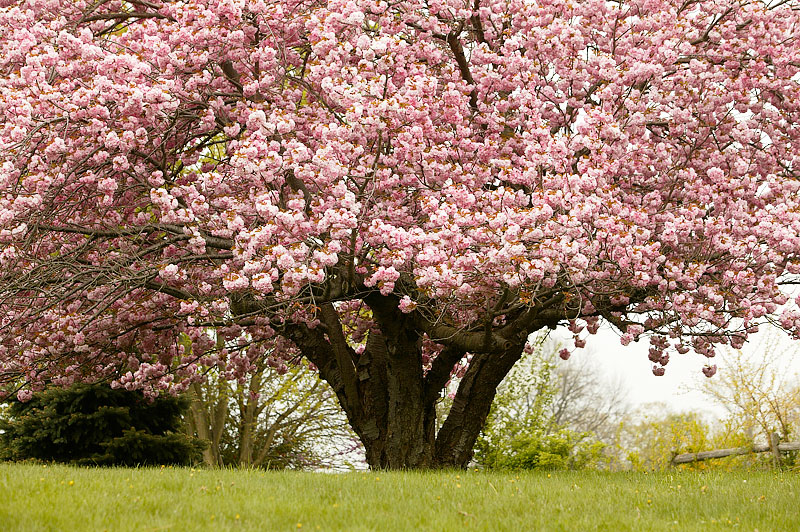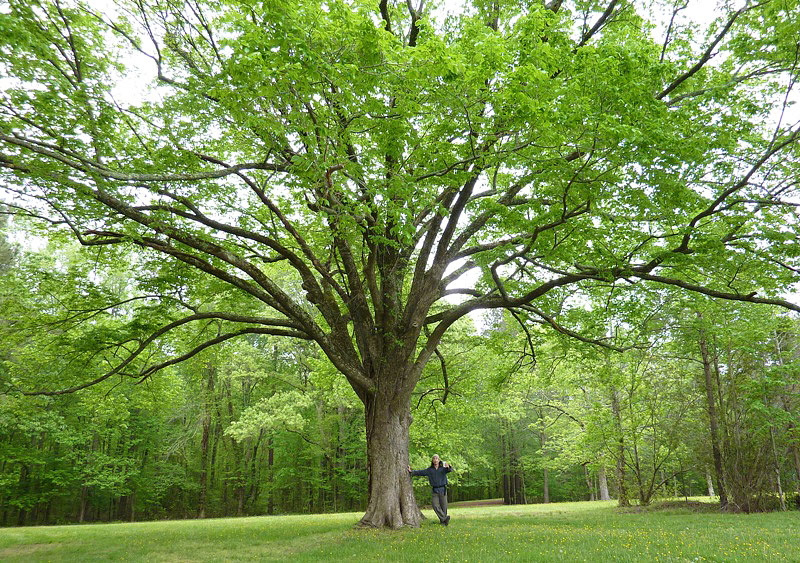
Tree maintenance helps you grow large, beautiful trees. These facts about trees tell you how they grow and how to nourish and protect them.
Tree Roots in the Lawn and Landscape
When you think about tree roots you may think of a large root system going far down into the ground. That is the case for some trees with long tap roots. But most tree roots grow out horizontally from the tree in the top 6-18 inches of soil. A mature tree’s roots can spread 2-3 times the diameter of the tree’s crown or canopy. A tree that’s 30 feet tall can have roots that reach out 60 – 90 feet from the trunk. That’s far past the dripline, which is the outside tip of the branches. In spite of this impressive measurement, the top of a mature tree is far heavier than the root system. A tree’s roots have quite a responsibility.
The roots of all plants serve to anchor the plant, absorb water and soil nutrients. The top 6 – 18 inches of soil is where the water and nutrients are. Small fibrous feeder roots grow where these elements are, as well as where the soil conditions are best.
Just as important to a tree’s health is oxygen. Adding even a couple of inches of soil over the existing topsoil can smother a tree. Compacted soil also prevents moisture and oxygen from getting down into the ground.
Competition for water and nutrients is one reason that grass often doesn’t grow well underneath trees. The tree will usually win unless you plant a shade-tolerant variety of grass.
Choosing the right shade tree or ornamental tree is important. It is also critical to get a tree planted properly to ensure that the root system has its best chance for success. When you choose and plant a tree, plan for the tree’s size at maturity. In addition to the height and width, include the amount of space needed for a healthy root system. Roots may cause damage to structures like sidewalks and driveways.

Remember that fertilizer and other chemicals like pesticides and herbicides are also going to be absorbed by the feeder roots. Deicing agents can runoff and harm a tree as well. Be cautious when using any chemical around trees. The damage may take several seasons to become visible. By then it may be too late. You should also maintain your tree’s health by using proper pruning techniques.
Protecting Tree Roots
Be aware of the root system when digging and aerating around trees to avoid cutting too many roots. Always use power equipment carefully around the base of trees.
Add a layer of mulch. Mulch helps retain moisture, maintain consistent soil temperature and protect roots from damage. Three to four inches is the maximum needed for a mature tree. More than that can actually be detrimental. The exception may be in extremely cold regions where frost heaving can disturb roots. Keep mulch away from the trunk to prevent the bark from rotting and keep hungry rodents from getting easy access to a free meal of bark.
Water one last time in the fall to help your trees survive the winter safely. The cold of winter can desiccate plants, especially when it’s combined with wind. Water slowly to avoid runoff. Apply water at or near the dripline and never water when the ground is frozen. Early in the day is best, especially when there’s a chance of freezing evening weather.

If you have scheduled a home renovation project, take time to protect your trees. The heavy equipment, machinery, stacks of material and foot traffic that contractors bring to the jobsite can actually harm your trees. The weight of all that material and activity can compact the soil in your lawn. Soil compaction prevents air and water from reaching tree roots. Compacted soil also causes water runoff and erosion. Soil compaction is difficult to reverse, so prevention is the key.
Put up a tree protection fence. Extend it out to the drip line or slightly beyond. Temporary fencing is commercially available or you can construct your own with stakes and rope. If you can’t construct a fence, spread a six-inch layer of organic mulch over the area to act as a cushion. Remove it after the project is completed.




Leave a Reply